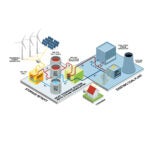The U.S. will seek to cut its greenhouse gas (GHG) emissions by 26% to 28% from 2005 levels by 2025, the White House said on March 31 in a target submitted to the United Nations Framework Convention on Climate Change (UNFCCC).
The submission—otherwise referred to as an Intended Nationally Determined Contribution (INDC)—is a formal statement of the U.S. target first announced as a result of a November agreement between President Obama and Chinese President Xi Jinping. China committed to peak its carbon dioxide emissions around 2030, and to boost its share of non-fossil fuel energy to around 20% by 2030, but it has not officially submitted a pledge to the UNFCCC.
By the March 31 informal deadline set by the United Nations in 2013, 33 countries accounting for nearly 60% of GHG emissions from energy had submitted plans to fight climate change beyond 2020. Many governments missed the deadline, which was set to provide time to compare pledges ahead of the global climate summit in Paris this December. That could complicate efforts to reach a new international climate agreement by the conclusion of the Paris summit, as agreed to by countries under the UNFCCC international treaty signed in 1992.
So far, the European Union has submitted a pledge to cut its emissions by 40% by 2030, compared with 1990 levels. Russia has pledged to cut emissions 25% on 1990 levels by 2030. Mexico, the first developing country to do so, last week made a climate commitment to slash its GHG emissions by at least 22% and up to 40% if certain conditions are met.
On March 31, Norway submitted a pledge offering to cut its GHG emissions by 40% by 2030, from 1990 levels—and to be carbon neutral by 2050.
The U.S. target compares to the Obama administration’s 2009 commitment to reduce emissions by 17% below 2005 levels by 2020. The Environmental Protection Agency’s June-proposed Clean Power Plan, meanwhile, seeks to slash carbon emissions from existing U.S. power plants by 30% from 2005 levels by 2030.
On Tuesday, a White House fact sheet on the INDC noted that the Clean Power Plan seeks to deliver $55 billion to $93 billion in annual net benefits by reducing carbon pollution and other harmful pollutants.
—Sonal Patel, associate editor (@POWERmagazine, @sonalcpatel)










